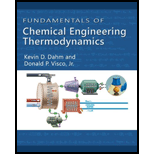
(A)
Interpretation:
The change in entropy for the system
Concept Introduction:
Write the expression to calculate the work done on contraction process.
Here, initial volume and final volume is
Write the expression to calculate the change in entropy for a system.
Here, final and initial entropy is
(B)
Interpretation:
The change in entropy for the system
Concept Introduction:
Write the expression to calculate the work done on contraction process.
Here, initial volume and final volume is
Write the expression to calculate the change in entropy for a system.
Here, final and initial entropy is
(C)
Interpretation:
The change in entropy for the system
Concept Introduction:
Write the expression to calculate the change in molar internal energy for an ideal gas.
Here, constant volume for an ideal gas is
Write the energy balance equation in terms of moles using first law of
Here, number of moles in the system is N.
Write the work expansion or contraction through the
Here, initial and final pressure are
(D)
Interpretation:
The change in entropy for the system
Concept Introduction:
Write the expression to calculate the change in molar internal energy for an ideal gas.
Here, constant volume for an ideal gas is
Write the energy balance equation in terms of moles using first law of thermodynamics.
Here, number of moles in the system is N.
Write the work expansion or contraction through the ideal gas law.
Here, initial and final pressure are
Trending nowThis is a popular solution!

Chapter 4 Solutions
Fundamentals of Chemical Engineering Thermodynamics (MindTap Course List)
 Introduction to Chemical Engineering Thermodynami...Chemical EngineeringISBN:9781259696527Author:J.M. Smith Termodinamica en ingenieria quimica, Hendrick C Van Ness, Michael Abbott, Mark SwihartPublisher:McGraw-Hill Education
Introduction to Chemical Engineering Thermodynami...Chemical EngineeringISBN:9781259696527Author:J.M. Smith Termodinamica en ingenieria quimica, Hendrick C Van Ness, Michael Abbott, Mark SwihartPublisher:McGraw-Hill Education Elementary Principles of Chemical Processes, Bind...Chemical EngineeringISBN:9781118431221Author:Richard M. Felder, Ronald W. Rousseau, Lisa G. BullardPublisher:WILEY
Elementary Principles of Chemical Processes, Bind...Chemical EngineeringISBN:9781118431221Author:Richard M. Felder, Ronald W. Rousseau, Lisa G. BullardPublisher:WILEY Elements of Chemical Reaction Engineering (5th Ed...Chemical EngineeringISBN:9780133887518Author:H. Scott FoglerPublisher:Prentice Hall
Elements of Chemical Reaction Engineering (5th Ed...Chemical EngineeringISBN:9780133887518Author:H. Scott FoglerPublisher:Prentice Hall
 Industrial Plastics: Theory and ApplicationsChemical EngineeringISBN:9781285061238Author:Lokensgard, ErikPublisher:Delmar Cengage Learning
Industrial Plastics: Theory and ApplicationsChemical EngineeringISBN:9781285061238Author:Lokensgard, ErikPublisher:Delmar Cengage Learning Unit Operations of Chemical EngineeringChemical EngineeringISBN:9780072848236Author:Warren McCabe, Julian C. Smith, Peter HarriottPublisher:McGraw-Hill Companies, The
Unit Operations of Chemical EngineeringChemical EngineeringISBN:9780072848236Author:Warren McCabe, Julian C. Smith, Peter HarriottPublisher:McGraw-Hill Companies, The





